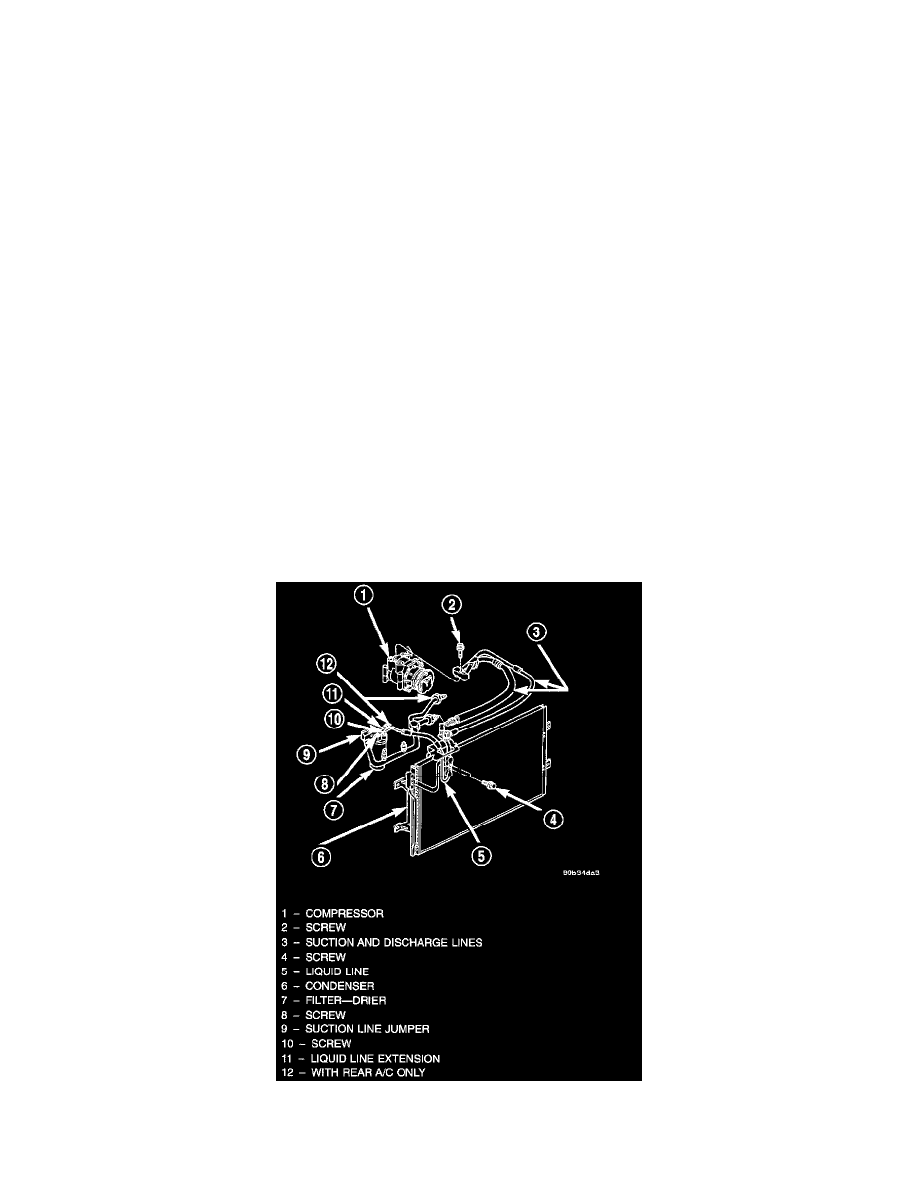RAM 2500 Van V8-5.9L VIN Z LDC (2000)

to the expansion valve and secure the connection with a screw. Tighten the mounting screw to 22 Nm (200 in. lbs.).
2. Remove the tape or plugs from the block fitting on the suction line jumper and the outlet of the filter-drier. Position the outlet of the filter-drier to
the suction line jumper block fitting and secure the connection with a screw. Tighten the mounting screw to 13.5 Nm (120 in. lbs.).
3. Reinstall the screw that secures the filter-drier to its mounting bracket. Tighten the mounting screw to 8.5 Nm (75 in. lbs.).
4. If the vehicle is equipped with the optional rear Heater-A/C unit, go to Step 5. If not, go to Step 7.
5. Remove the tape or plugs from the refrigerant line fittings on the underbody plumbing liquid line and the liquid line extension. Connect the flare
nut on the underbody plumbing liquid line to the threaded fitting on the liquid line extension. Tighten the fitting to 27 Nm (244 in. lbs.).
6. Remove the tape or plugs from the refrigerant line fittings on the underbody plumbing suction line and the suction line jumper. Connect the flare
nut on the underbody plumbing suction line to the threaded fitting on the suction line jumper. Tighten the fitting to 47 Nm (420 in. lbs.).
7. Remove the tape or plugs from the refrigerant line fittings on the suction line and the suction line jumper. Connect the flare nut on the suction line
to the threaded fitting on the suction line jumper. Tighten the fitting to 47 Nm (420 in. lbs.).
8. Install the low pressure cut-off switch to the fitting on the suction line jumper.
9. Connect the battery negative cable.
10. Evacuate the refrigerant system.
11. Charge the refrigerant system.
Suction and Discharge Line Replacement
Any kinks or sharp bends in the refrigerant plumbing will reduce the capacity of the entire air conditioning system. Kinks and sharp bends reduce the
flow of refrigerant in the system. A good rule for the flexible hose refrigerant lines is to keep the radius of all bends at least ten times the diameter of the
hose. In addition, the flexible hose refrigerant lines should be routed so they are at least 80 mm (3 inches) from the exhaust manifold.
High pressures are produced in the refrigerant system when the air conditioning compressor is operating. Extreme care must be exercised to make sure
that each of the refrigerant system connections is pressure-tight and leak free. It is a good practice to inspect all flexible hose refrigerant lines at least
once year to make sure they are in good condition and properly routed.
WARNING: REVIEW THE WARNINGS AND CAUTIONS BEFORE PERFORMING THE FOLLOWING OPERATION.
REMOVAL
1. Disconnect and isolate the battery negative cable.
2. Recover the refrigerant from the refrigerant system.
3. Unplug the wire harness connector from the high pressure cut-off switch.
4. Remove the radiator grille from the vehicle.
Suction And Discharge Line Remove/Install
5. Remove the screw that secures the block fitting on the discharge line to the block fitting on the inlet of the condenser, and separate the fitting from
